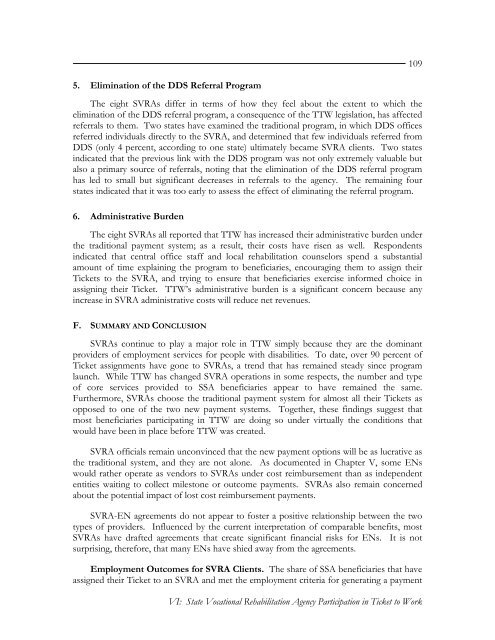Evaluation of the Ticket to Work Program, Implementation ...
Evaluation of the Ticket to Work Program, Implementation ...
Evaluation of the Ticket to Work Program, Implementation ...
Create successful ePaper yourself
Turn your PDF publications into a flip-book with our unique Google optimized e-Paper software.
1095. Elimination <strong>of</strong> <strong>the</strong> DDS Referral <strong>Program</strong>The eight SVRAs differ in terms <strong>of</strong> how <strong>the</strong>y feel about <strong>the</strong> extent <strong>to</strong> which <strong>the</strong>elimination <strong>of</strong> <strong>the</strong> DDS referral program, a consequence <strong>of</strong> <strong>the</strong> TTW legislation, has affectedreferrals <strong>to</strong> <strong>the</strong>m. Two states have examined <strong>the</strong> traditional program, in which DDS <strong>of</strong>ficesreferred individuals directly <strong>to</strong> <strong>the</strong> SVRA, and determined that few individuals referred fromDDS (only 4 percent, according <strong>to</strong> one state) ultimately became SVRA clients. Two statesindicated that <strong>the</strong> previous link with <strong>the</strong> DDS program was not only extremely valuable butalso a primary source <strong>of</strong> referrals, noting that <strong>the</strong> elimination <strong>of</strong> <strong>the</strong> DDS referral programhas led <strong>to</strong> small but significant decreases in referrals <strong>to</strong> <strong>the</strong> agency. The remaining fourstates indicated that it was <strong>to</strong>o early <strong>to</strong> assess <strong>the</strong> effect <strong>of</strong> eliminating <strong>the</strong> referral program.6. Administrative BurdenThe eight SVRAs all reported that TTW has increased <strong>the</strong>ir administrative burden under<strong>the</strong> traditional payment system; as a result, <strong>the</strong>ir costs have risen as well. Respondentsindicated that central <strong>of</strong>fice staff and local rehabilitation counselors spend a substantialamount <strong>of</strong> time explaining <strong>the</strong> program <strong>to</strong> beneficiaries, encouraging <strong>the</strong>m <strong>to</strong> assign <strong>the</strong>ir<strong>Ticket</strong>s <strong>to</strong> <strong>the</strong> SVRA, and trying <strong>to</strong> ensure that beneficiaries exercise informed choice inassigning <strong>the</strong>ir <strong>Ticket</strong>. TTW’s administrative burden is a significant concern because anyincrease in SVRA administrative costs will reduce net revenues.F. SUMMARY AND CONCLUSIONSVRAs continue <strong>to</strong> play a major role in TTW simply because <strong>the</strong>y are <strong>the</strong> dominantproviders <strong>of</strong> employment services for people with disabilities. To date, over 90 percent <strong>of</strong><strong>Ticket</strong> assignments have gone <strong>to</strong> SVRAs, a trend that has remained steady since programlaunch. While TTW has changed SVRA operations in some respects, <strong>the</strong> number and type<strong>of</strong> core services provided <strong>to</strong> SSA beneficiaries appear <strong>to</strong> have remained <strong>the</strong> same.Fur<strong>the</strong>rmore, SVRAs choose <strong>the</strong> traditional payment system for almost all <strong>the</strong>ir <strong>Ticket</strong>s asopposed <strong>to</strong> one <strong>of</strong> <strong>the</strong> two new payment systems. Toge<strong>the</strong>r, <strong>the</strong>se findings suggest thatmost beneficiaries participating in TTW are doing so under virtually <strong>the</strong> conditions thatwould have been in place before TTW was created.SVRA <strong>of</strong>ficials remain unconvinced that <strong>the</strong> new payment options will be as lucrative as<strong>the</strong> traditional system, and <strong>the</strong>y are not alone. As documented in Chapter V, some ENswould ra<strong>the</strong>r operate as vendors <strong>to</strong> SVRAs under cost reimbursement than as independententities waiting <strong>to</strong> collect miles<strong>to</strong>ne or outcome payments. SVRAs also remain concernedabout <strong>the</strong> potential impact <strong>of</strong> lost cost reimbursement payments.SVRA-EN agreements do not appear <strong>to</strong> foster a positive relationship between <strong>the</strong> twotypes <strong>of</strong> providers. Influenced by <strong>the</strong> current interpretation <strong>of</strong> comparable benefits, mostSVRAs have drafted agreements that create significant financial risks for ENs. It is notsurprising, <strong>the</strong>refore, that many ENs have shied away from <strong>the</strong> agreements.Employment Outcomes for SVRA Clients. The share <strong>of</strong> SSA beneficiaries that haveassigned <strong>the</strong>ir <strong>Ticket</strong> <strong>to</strong> an SVRA and met <strong>the</strong> employment criteria for generating a paymentVI: State Vocational Rehabilitation Agency Participation in <strong>Ticket</strong> <strong>to</strong> <strong>Work</strong>
















